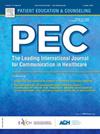Combining telephone and online channels: Experiences of the Dutch STI sex information helpline
IF 2.9
2区 医学
Q2 PUBLIC, ENVIRONMENTAL & OCCUPATIONAL HEALTH
引用次数: 0
Abstract
Introduction
The Dutch STI Sex Information Helpline has gradually expanded its telephone services to include online services via email and online chat. In addition, a thematic broadening of AIDS and HIV-related support took place, covering almost all Sexual and Reproductive Health and Rights topics. Since 2015, the helpline collaborates closely with public sexual health clinics' nurses to provide online chat-services.
Objectives
This article explores similarities and differences among callers, emailers, and chatters, including their background characteristics, reasons for contact, characteristics of the contacts, satisfaction with the service, and channel preferences. Furthermore, it describes how nurses evaluate national cooperation in the online chat-service and the added value they perceive in relation to their work at the public sexual health clinics.
Methods
In this mixed method cross-sectional design study registration data of the Helpline of 2018 (N = 17.585) is analysed in combination with analyses of a client satisfaction study among users of all three channels in 2018 (N = 488). In addition, an online evaluation survey was conducted among nurses who participate in the online chat-service in 2022 (N = 35).
Results
This study shows that online chat is the most frequently used channel, yet there is substantial demand for email and telephone services. Channel selection depends on the background characteristics of clients, the content of the help request and personal preferences and needs. Users equally rate all channels positively. Nurses assess their participation in the chat-service as an added value to their work in the clinics and endorse the importance of national cooperation.
Conclusions
Offering sexual health information services via phone, online chat, and email allows a helpline to serve a diverse public. Despite online chat being the most popular, usage and satisfaction is high across all channels, indicating effective user choice. A mix of channels does not only extends a helpline's reach, it also enhances the accessibility of public sexual health care through its connecting role.
Practical implications
While online chat is popular, it also consumes a considerable amount of professionals' time. This requires an efficient strategy for offering the three channels in a coherent manner.
结合电话和网络渠道:荷兰性传播感染信息热线的经验
荷兰性传播感染信息热线已逐步扩大其电话服务,包括通过电子邮件和在线聊天提供的在线服务。此外,还扩大了与艾滋病和艾滋病毒有关的支助的专题范围,几乎涵盖了所有性健康和生殖健康及权利专题。自2015年以来,该热线与公共性健康诊所的护士密切合作,提供在线聊天服务。本文探讨了来电者、电子邮件者和聊天者之间的异同,包括他们的背景特征、联系原因、联系特征、服务满意度和渠道偏好。此外,它还描述了护士如何评估在线聊天服务方面的国家合作,以及她们在公共性健康诊所的工作中所感知到的附加价值。方法结合2018年三个渠道用户的客户满意度研究(N = 488),对2018年求助热线注册数据(N = 17.585)进行混合截面设计研究分析。并于2022年对参与在线聊天服务的护士进行在线评价调查(N = 35)。结果该研究表明,在线聊天是最常用的渠道,但对电子邮件和电话服务的需求很大。渠道的选择取决于客户的背景特征、请求帮助的内容以及个人的喜好和需求。用户对所有渠道的评价都是相同的。护士们认为她们参与聊天服务是对她们在诊所工作的一种附加价值,并赞同国家合作的重要性。结论通过电话、网上聊天和电子邮件等方式提供性健康信息服务,可以使热线服务于不同的人群。尽管在线聊天是最受欢迎的,但所有渠道的使用率和满意度都很高,表明用户有有效的选择。多种渠道的结合不仅扩大了求助热线的覆盖范围,还通过其联系作用提高了公共性保健服务的可及性。实际意义虽然在线聊天很流行,但它也消耗了大量的专业人士的时间。这需要一个有效的战略,以连贯的方式提供这三个渠道。
本文章由计算机程序翻译,如有差异,请以英文原文为准。
求助全文
约1分钟内获得全文
求助全文
来源期刊

Patient Education and Counseling
医学-公共卫生、环境卫生与职业卫生
CiteScore
5.60
自引率
11.40%
发文量
384
审稿时长
46 days
期刊介绍:
Patient Education and Counseling is an interdisciplinary, international journal for patient education and health promotion researchers, managers and clinicians. The journal seeks to explore and elucidate the educational, counseling and communication models in health care. Its aim is to provide a forum for fundamental as well as applied research, and to promote the study of organizational issues involved with the delivery of patient education, counseling, health promotion services and training models in improving communication between providers and patients.
 求助内容:
求助内容: 应助结果提醒方式:
应助结果提醒方式:


